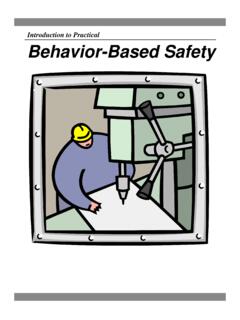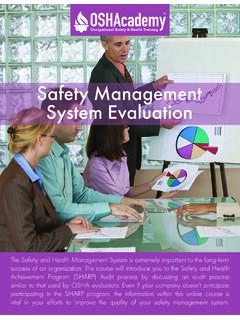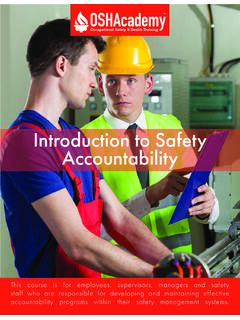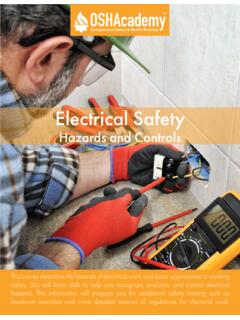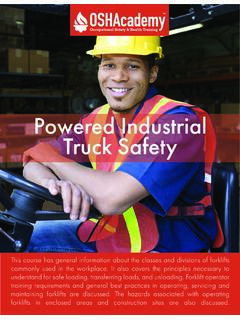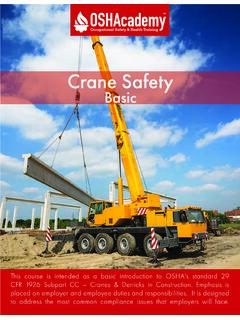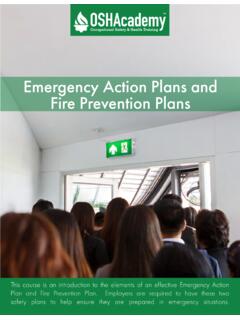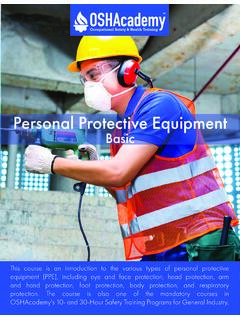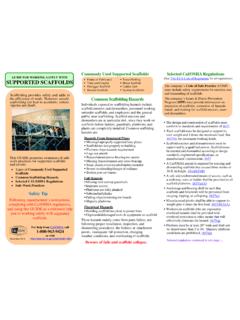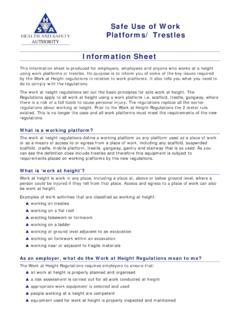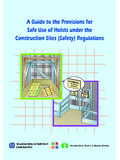Transcription of 817 Steel Erection Safety - OSHAcademy
1 Despite being covered since 1971 under the original Steel Erection standard, America's 56,000 Steel erectors continue to suffer 35 fatal accidents per year, a rate of one death per 1,600 workers. The Bureau of Labor and Statistics lists Steel Erection as one of the top 10 most hazardous occupations. Steel Erection work includes heavy duty high rise structures, metal buildings, and even signs. Steel Erection is often the skeletal core of bridges, office buildings, commercial, retail, and industrial structures. This course contains important information to protect your employees and their co-workers who are engaged in Steel Erection projects on your Erection Safety This page intentionally blank OSHA cademy Course 817 Study Guide Steel Erection Safety Copyright 2022 Geigle Safety Group, Inc.
2 No portion of this text may be reprinted for other than personal use. Any commercial use of this document is strictly forbidden. Contact OSHA cademy to arrange for use as a training document. This study guide is designed to be reviewed off-line as a tool for preparation to successfully complete OSHA cademy Course 817. Read each module, answer the quiz questions, and submit the quiz questions online through the course webpage. You can print the post-quiz response screen which will contain the correct answers to the questions. The final exam will consist of questions developed from the course content and module quizzes.
3 We hope you enjoy the course and if you have any questions, feel free to email or call: OSHA cademy 15220 NW Greenbrier Parkway, Suite 230 Beaverton, Oregon 97006 +1 (888) 668-9079 Disclaimer This document does not constitute legal advice. Consult with your own company counsel for advice on compliance with all applicable state and federal regulations. Neither Geigle Safety Group, Inc., nor any of its employees, subcontractors, consultants, committees, or other assignees make any warranty or representation, either express or implied, with respect to the accuracy, completeness, or usefulness of the information contained herein, or assume any liability or responsibility for any use, or the results of such use, of any information or process disclosed in this publication.
4 GEIGLE Safety GROUP, INC., DISCLAIMS ALL OTHER WARRANTIES EXPRESS OR IMPLIED INCLUDING, WITHOUT LIMITATION, ANY WARRANTIES OF MERCHANTABILITY OR FITNESS FOR A PARTICULAR PURPOSE. Taking actions suggested in this document does not guarantee that an employer, employee, operator or contractor will be in compliance with applicable regulations. Ultimately every company is responsible for determining the applicability of the information in this document to its own operations. Each employer s Safety management system will be different. Mapping Safety and environmental management policies, procedures, or operations using this document does not guarantee compliance regulatory requirements.
5 Revised: January 27, 2022 This page intentionally blank Course 817 Contents Course Introduction .. 1 Course Objectives .. 1 Module 1: Site Preparation .. 3 Approval and Commencement .. 3 Site Layout .. 3 Pre-Planning .. 4 Site-Specific Erection 4 The Site-Specific Erection Plan Process .. 5 The Site-Specific Erection Plan Components .. 5 Module 1 Quiz .. 7 Module 2: Cranes .. 9 Hoisting and 9 Hoisting Equipment .. 9 Pre-Shift Inspection .. 9 Operator and Rigger Inspection 11 Working Under Loads .. 11 Multiple Lift Rigging Procedures .. 12 Module 2 Quiz .. 14 Module 3: Structural Stability.
6 16 Structural Steel Assembly .. 16 Case Report .. 16 Multi-Story Structures .. 16 Walking/Working Surfaces .. 17 Course 817 Shear Connectors .. 17 Coated Surfaces .. 17 Plumbing-Up .. 18 Metal Decking .. 18 Hoisting, Landing and Placing Metal Deck Bundles .. 18 Roof and Floor Holes and Openings .. 18 Covering Roof and Floor Openings .. 19 Installation of Metal Decking .. 20 Derrick Floors .. 20 Module 3 Quiz .. 21 Module 4: Structural Stability (Continued) .. 23 Column Anchorages .. 23 Erection Stability .. 23 Anchor Rods (Anchor Bolts) .. 23 Beams and Columns .. 24 Releasing the Load .. 24 Cantilevered Members.
7 24 Diagonal Bracing .. 25 Double Connections at Columns .. 25 Column Splices .. 26 Perimeter Columns .. 26 Module 4 Quiz .. 28 Module 5: Structural Stability (Continued) .. 30 Open Web Steel Joists .. 30 Course 817 General Requirements .. 30 Installing Stabilizing Joists .. 31 Steel Joists and Steel Joist Girders .. 32 Erection of Steel Joists .. 33 Erection Bridging .. 34 Landing and Placing Loads .. 35 Real-World Accident .. 36 Module 5 Quiz .. 37 Module 6: Metal Buildings and Overhead Hazards .. 39 Metal Buildings .. 39 Systems-Engineered Metal Buildings .. 39 Construction Loads .. 39 Girts or Eave Struts.
8 39 Purlins and Girts .. 40 Overhead Hazards .. 40 Falling Object Protection .. 40 The Hazards Associated with Placing Joists .. 41 Module 6 Quiz .. 42 Module 7: Fall Protection .. 44 General Requirements .. 44 Connectors .. 44 Controlled Decking Zone (CDZ) .. 45 Control Lines .. 46 What OSHA Inspects .. 46 Course 817 Module 7 Quiz .. 48 Module 8: Steel Erection Safety Training .. 50 Qualified Persons .. 50 Case Report .. 50 Fall Hazards .. 51 Special Training .. 51 Case Report .. 52 Why Quality Steel Erection Construction is Important .. 52 Module 8 Quiz .. 53 Definitions .. 55 Endnotes .. 60 Course 817 Copyright 2022 Geigle Safety Group, Inc.
9 Page 1 of 60 Course Introduction Despite being covered since 1971 under the original Steel Erection standard, America's 56,000 Steel erectors continue to suffer 35 fatal accidents per year, a rate of one death per 1,600 workers. OSHA estimates 30 of those deaths, as well as nearly 1,150 annual lost-workday injuries, can be averted by compliance with provisions of the OSHA s 1926 Subpart R Standard, developed with industry and labor through negotiated rulemaking. The Bureau of Labor and Statistics lists Steel Erection as one of the top 10 most hazardous occupations. Steel Erection work includes heavy duty high rise structures, metal buildings, and even signs.
10 Steel Erection is often the skeletal core of bridges, office buildings, commercial, retail, and industrial structures. OSHA published Subpart R, , the current Steel Erection rule. The OSHA Steel Erection standard is intended to protect employees from Steel Erection hazards when involved in the construction, alteration, or repair of: single-story buildings multi-story buildings bridges other structures where Steel Erection occurs The requirements apply to all employers engaged in Steel Erection unless otherwise specified. It does not cover electrical transmission towers, communication and broadcast towers, or tanks.

